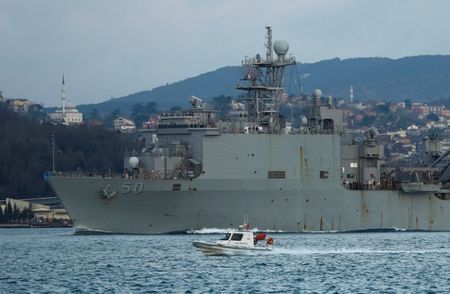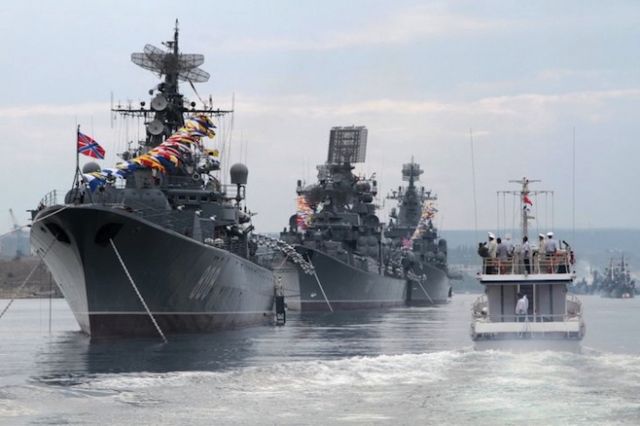

| Online: | |
| Visits: | |
| Stories: |
Russian Gen Staff Considers US Patrol in Black Sea as a Security Threat
Russian Gen Staff considers US Patrol in Black Sea as a Security Threat

Photo: Bulgarian and NATO navy ships take part in a Bulgarian-NATO military navy exercise in the Black Sea, east of Sofia (Getty)
Head of the Russian General Staff said on Tuesday that the US patrol in the Black sea presents a potential threat to the security of the Russian Federation, because it’s not clear what rockets are on the patrol ships.
Uncertainty over what type of weapons are loaded onto the United States’ Navy ships patrolling the Black Sea and the Baltic Sea pose a potential threat to Russia, the Russian General Staff’s deputy chief said Tuesday.

Photo: USS Carter Hall, a dock landing ship of the United States Navy, sets sail in the Bosphorus, on its way to the Black Sea, in Istanbul, Turkey, March 17, 2017. (REUTERS)
“Ballistic missile defense ships patrolling the Black and Baltic seas are a threat to the facilities of the European part of Russia because there is uncertainty over which weapons are currently loaded onto launchers: interceptor missiles or cruise missiles,” Lt. Gen. Viktor Poznikhir said.

Photo: US Patrol Ships / Black Sea (AFP 2017)
Speaking at the Conference on Disarmament in Geneva, Poznikhir said that the possibility of using ground versions in Romania and Poland of ship-based launchers to deploy Tomahawk cruise missiles directly violates the Intermediate-Range Nuclear Forces Treaty (INF Treaty).
“An equally serious threat to Russian and Chinese security is the strike potential of ballistic missile defense groups. US Navy cruisers and destroyers equipped with interceptor missiles are simultaneously carriers of Tomahawk cruise missiles with a range of up to 2,500 kilometers”

Photo: A US amphibious dock landing ship Carter Hall entered the Black Sea last week to participate in bilateral exercises with Romania.
“The ship is deployed with the Bataan Amphibious Ready Group to support maritime security operations and theater security cooperation efforts in the US 6th Fleet area of operations,” the US Navy press release stated on March 23.
The U.S. Navy 6th Fleet takes part in a North Atlantic Treaty Organization (NATO) military buildup in Eastern Europe, which has increased tensions with Russia that developed after a 2013 coup in Ukraine.
Russia has repeatedly warned that a build-up of NATO troops and military equipment on or in the vicinity of its borders is provocative, contrary to previous agreements and can lead to a destabilization of the region.
Russia, which annexed Ukraine’s Crimea in 2014, has its own Black Sea Fleet based at Sevastopol.
 Photo: Russian warships are seen during a naval parade rehearsal in the Crimean port of Sevastopol.
Photo: Russian warships are seen during a naval parade rehearsal in the Crimean port of Sevastopol.
If we look at the situation from a military point of view, Russia’s ground operation to annex Crimea in 2014 happened in an exceptionally clean way, amplifying an opportunity to demonstrate the results of Moscow’s military modernization efforts. On the other hand, for Russia’s famous Black Sea Fleet, the most tactically relevant action available was to deny Ukrainian ships setting to sea by scuttling one of it’s oldest and rustiest cruisers in the mouth of a channel.
Since 2008 and despite all efforts to upgrade Russia’s old Soviet-age military, the Black Sea Fleet in year 2014 was a decrepit shell of the once great outfit. With an agreement in place, the independent Ukrainen has allowed Russia to keep its ships in Crimea since the fall of the Soviet Union. However, this largerly prevented additional Russian ships from being added. Most of that fleet spent over 25 years rusting away at their moorings and many doubted if the fleet was capable of combat anymore.
This then led to military stagnation in Crimea, but the agreement still was tolerated in Moscow for many years. This situation changed with the rise of the Maidan protest movement in Kiev. With a pro-Western government formed and providing support, the Kremlin could not longer be sure its basing agreements in Crimea would be honored.
Within two years of the annexation, the fleet’s fortune and capabilities have profoundly changed. Moscow did not waste any time before diverting resources to rejuvenating the fleet, adding around a dozen combat vessels since 2014 and thus, Sevastopol now is a major hub of Russian military and geopolitical power projection.


The creation of a “defense in depth” arrangement in the Black Sea kicked into high-gear two months after Crimea’s annexation. In May 2014, Defense Minister Sergei Shoigu announced that 68 billion rubles ($957 million) would be diverted from a 20 trillion ruble ($292 billion) military modernization budget to overhaul the fleet. Officials at the time claimed that would buy the Black Sea Fleet some 80 new ships. That number is undoubtedly misleading, as it also counts tugboats among the new assets.
Rearmament takes time, especially when talking about ships. The first deliveries of new vessels to the Black Sea were completed by the end of 2014, with two Improved Kilo-class diesel-electric submarines inducted into the fleet. Two more Improved Kilo-class subs were delivered in 2015, and a final two submarines are scheduled for delivery this year.
In total, the Black Sea Fleet received around 15 vessels of various sizes and classes, according to data collected by CAST. In addition to the submarines, these included seven patrol boats and two missile corvettes.
The heavier surface combatants are expected to go into service with the fleet later this year, and include three brand-new Admiral Grigorovich-class frigates. Three more are on the way, but an unintended consequence of Russia’s war with Ukraine has been the loss of Ukrainian engine deliveries for the large ships, leading to delays. And an additional 15 new missile corvettes are expected by 2020, according to CAST.
When judged by size, the beefing up of the Black Sea Fleet may appear to be anti-climactic to citizens of Western nations that field large navies comprised of increasingly large and complex ships — such as the United States. But what makes the modernized capabilities of the Black Sea Fleet noteworthy is the key capability shared by the Kilo-class submarines, the Grigorovich-class frigates, and small missile corvettes: they all serve as launch platforms for Russia’s brand-new Kalibr land attack cruise missiles.
The Kalibr turned heads in October 2015, when Russia’s Caspian Flotilla launched a major salvo of the new cruise missiles from the Caspian Sea to hit alleged terrorist groups in Syria. The strike demonstrated that Russia now has long-range guided attack capabilities, which it previously lacked.
In addition to the new ships, Russia’s has stepped up land-based defenses. Missile and coastal defense systems now cover the peninsula, and new fighter and bomber wings are stationed at Crimean airfields.
The net result of this activity is simple: in two years Russia has created an elaborate defensive zone covering Crimea and most of the Black Sea region. With this net, it can both throw its weight around the neighborhood and seriously deter any potential foe from entering the Black Sea.
With even heavier additions on the way, Russia is on track to reassert itself as the dominant naval power in the Black Sea region.





GEE…YA…THINK…. Can you blame them?????… If a fleet of Russian war ships were sailing around the gulf of Mexico or the coast of New York would our government be a little concerned? The U.S. Government has been hijacked by psychopathic, war mongering morons that actually think the people are as stupid as they are. We know who the aggressor is & the war crimes they are already guilty of, we just need to purge them from our government & that day is coming…